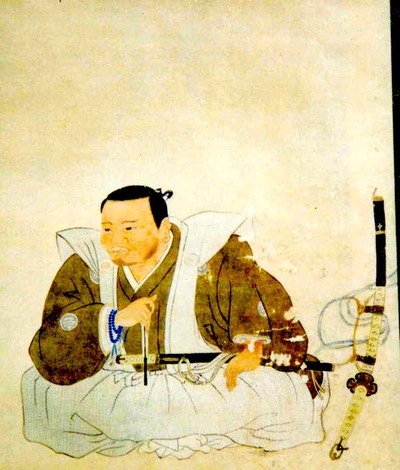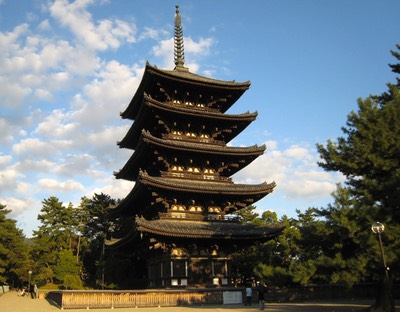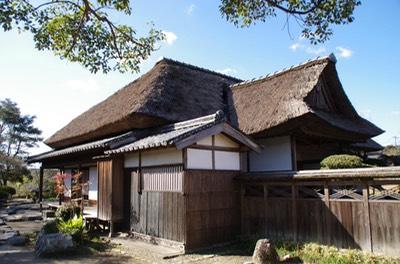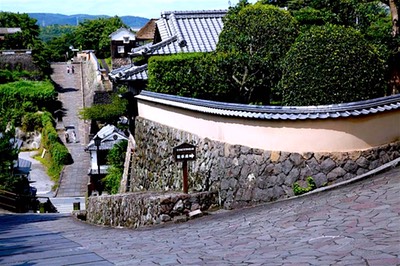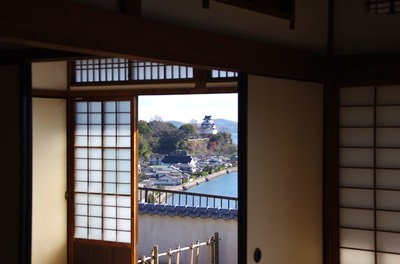Kitsuki is perhaps one of the places least associated with Musashi. Yet it is almost certain that, following his first battle experiences during Kuroda Yoshitaka’s (1546–1604) campaign to subdue northern Kyushu (see Musashi’s Battles), Musashi moved from Nakatsu to Kitsuki with his father, Muni, when the latter became fencing instructor to Nagaoka (Matsui) Yasuyuki (1550–1612), the master of Kitsuki castle and Hosokawa Tadatoshi’s most trusted vassal (see Musashi’s Father).
Kitsuki is situated at the foot of Morie Bay, on the eastern side of the Kunisaki Peninsula, some thirty miles east from Nakatsu in the neighboring province of Bungo. The Kitsuki fief belonged to Hosokawa Tadaoki (1563–1646), who had received it in reward for choosing Tokugawa Ieyasu’s side agains Ishida Mitsunari in the run-up to the Battle of Sekigahara.
Musashi visited his father (who had now taken the Buddhist name of Munisai) again in the fall of 1612 not long after his famous duel with Sasaki Kojirō on Ganryū Island, a duel that had been arranged by Nagaoka Okinaga. The Numata kaki describes how he first found refuge at Moji castle, the then residence of Hosokawa Tadatoshi, but that:
其後武蔵を豊後へ被送遣候、石井三之丞と申馬乗に、鉄砲之共ども御附被成、道を致警護無別条豊後へ送届武蔵無二斎と申者に相渡申候由に御座候。
Afterward, Musashi was brought to the province of Bungo. He was given an escort by Ishii Mitsunojō, who secured the way with men on horseback, who were armed with muskets and ensured that Musashi arrived in Bungo unharmed. There he delivered him to the house of a man by the name of Munisai.
Once the proud headquarters of Nagaoka Okinaga, Kitsuki caslte’s original structures have long since gone, having been dismantled during the Meiji period. The castle’s main structure originally stood on the crest of Daiyama, a hill on the northern bank of the Yasaka River and overlooked Morie Bay. But a rapid succession of earthquakes and typhoons at the end of the sixteenth century caused the then owner, Sugihara Nagafusa (1574–1629) to move the residential quarters to the foot of the hill’s northern slope. A ferro-cement replica of the castle’s main tower, built during the 1970s, now graces the hill’s slope, and houses a small museum.
Nowadays, Kitsuki is perhaps best known for the traditional living quarters of the local samurai. These so-called buke yashiki (武家屋敷) stand on a hill that stretches westward from the castle. One can reach them by climbing a long stone-pathed stairway of fifty-three steps on the hill’s eastern slope. Atop the hill the narrow road is flanked long tsuchikabe, the traditional plastered walls. Some end in beautifully preserved roofed gateways through which one can enter their artfully designed gardens. The narrow road terminates in the Suya no Saka, a sloping road (saka) at the foot of which once stood a vinegar shop (suya).
Most of the bukke yashiki in Kitsuki date back to the time the fiefdom was under the control of the Matsudaira clan, when they became masters of the domain in 1645. Yet it was in such a similar yashiki that Musashi once lived with his father, Muni, after the latter had entered the service of Nagaoka Okinaga during the first decade of the seventeenth century.
Any queries of remarks? Launch or join a discussion at our new FORUM
